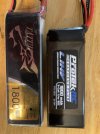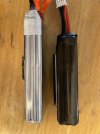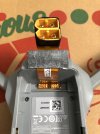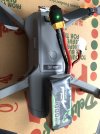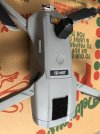It's 15-16 satellites on the ground and in the house with the battery on the top. It 20-21 after I take off for a minute or so.Hey OP next time you take flight with this extra battery, let it sit powered up for several minutes and see what your satellite count is.
have a feeling you are blocking the GPS, although you may have a high enough count for decent flight profile, if you only have like 9 satellites you are 1 away from loosing holding ability. Neat concept either way.
You are using an out of date browser. It may not display this or other websites correctly.
You should upgrade or use an alternative browser.
You should upgrade or use an alternative browser.
New Air2S $30 battery mod giving 35% extra battery life. Lightweight 1800mah 70c Battery Attached - 7-29-2021
- Thread starter Interficiam Stercore
- Start date
-
- Tags
- air 2s battery mod
I got the recommention of 3s 75Cmin 11.1v, with 500mah min. from the manufacturer of the adaptor cable. The heat does build up by the end of the flight. But, that is mostly due to ambient outdoor temps and the battery weight. It's maximum temp has been 60C or 140F in 95F degree weather.The remote usually gives a warning and decreases flight performance at 65C or 150F. I usually proceed to land when I hit 55C. So by the time I land I haven't hit the critical 65C.With this mod don't you have to worry about matching the extra cell to the internal cells of the stock battery? The internal cells are chosen to be matched to make the "pack". Mismatched cells can create a fire hazard.
I'd worry about heat buildup in the battery and in the drone itself since it wasn't designed for these extended flight times. At the very least the ma2 hasn't been tested by dji for these flight times.
Like another poster pointed out...I'd be curious to know any impact this may have in GPS satellite reception.
Very cool and clever idea with nice results so far...but I'd be a bit leery.
If I'm at home, I immediately put the battery in the freezer for 5 minutes until it's room temp. It can be charged in about 5 minutes after I take it out of the freezer, after the hot and cold temps redistribute themselves and the battery is equal in temp throughout all the cells. It goes from 150F to 75F while in the freezer for 5 minutes.
I'm always watching for battery swelling. The best way to check is to put the battery on a flat surface and see if it wobbles. Then you know the bottom of the battery is swollen. No problems yet though. I made a 30 minute hovering hyperlapse the other day and the Batt hit 60C in 95 degree weather. Without the battery I only get 20 minutes of hover time in the real world and can only get short hyperlapse videos once I reach 300-400ft. The 60C temps haven't had any untoward effects , yet.
If anything happens, i'll be the first to let you know.
By the way, see post #21 for my satellite numbers. They are normal. More than enough, especially in flight.
Size of LiHV 11.4 v 1800mah graphene batt vs Size of Standard Lipo 11.1v 1800mah. See images. I'll weigh them when I recieve a scale (see post #26). 85mm length for the LiHV 11.4v and 105mm for the Lipo 11.1v.
Attachments
Last edited:
StantonZ
Well-Known Member
Now that I've successfully implemented this "mod", I thought I would post some pics and comments.
I didn't build any sort of "backboard" for the XT60 connector, since it is supported by the battery cable when in use (pic #2)...and a small double-sided sticker when not in use (pic #3). I've also decided to stick with battery packs ~70mm in length as opposed to ~105mm in length (which seems to be the cutoff between ~1300 mAh packs and the higher capacity 2000+ mAh packs), since they allow easy insertion/removal of the main battery--not to mention access to the power on/off button. This opens the door for other (higher power) battery pack configurations in the future that conform to this length x width profile (height is not so critical). However, additional capacity also means additional weight, which eventually becomes a problem.
I've also noticed another interesting thing when connecting/disconnecting the mod battery: depending on the voltage (and a full battery tops out at >12v), the main battery acts like it's being charged...which means you have to power-up the drone before connecting the mod battery. In addition, when examining the Efficiency tab in the Power section of Airdata tool, I noticed a dramatic increase in the "minutes per battery" and "miles per battery" dials as well as a voltage bump in the Cells Graph tab, which confirms what the DJI app cannot: that there is definitely additional capacity on board!
As for the earlier comment about cell matching between battery packs: while "nice to have" it isn't necessary for proper operation. In fact, if you charge via the "cell balancing" port that these batteries come with, you should be able to come close to matching voltages across all cells (assuming the drone BMS does it's job).
I didn't build any sort of "backboard" for the XT60 connector, since it is supported by the battery cable when in use (pic #2)...and a small double-sided sticker when not in use (pic #3). I've also decided to stick with battery packs ~70mm in length as opposed to ~105mm in length (which seems to be the cutoff between ~1300 mAh packs and the higher capacity 2000+ mAh packs), since they allow easy insertion/removal of the main battery--not to mention access to the power on/off button. This opens the door for other (higher power) battery pack configurations in the future that conform to this length x width profile (height is not so critical). However, additional capacity also means additional weight, which eventually becomes a problem.
I've also noticed another interesting thing when connecting/disconnecting the mod battery: depending on the voltage (and a full battery tops out at >12v), the main battery acts like it's being charged...which means you have to power-up the drone before connecting the mod battery. In addition, when examining the Efficiency tab in the Power section of Airdata tool, I noticed a dramatic increase in the "minutes per battery" and "miles per battery" dials as well as a voltage bump in the Cells Graph tab, which confirms what the DJI app cannot: that there is definitely additional capacity on board!
As for the earlier comment about cell matching between battery packs: while "nice to have" it isn't necessary for proper operation. In fact, if you charge via the "cell balancing" port that these batteries come with, you should be able to come close to matching voltages across all cells (assuming the drone BMS does it's job).
Attachments
Aerial Edge
Well-Known Member
It's 15-16 satellites on the ground and in the house with the battery on the top. It 20-21 after I take off for a minute or so.
Wow that is pretty good overall. Even in the house! Thanks for that update
Weight of LiHV 11.4 v 1800mah graphene batt IS 4.8oz vs Weight of Standard Lipo 11.1v 1800mah IS 5.2oz.
FOR A GRAND TOTAL OF 0.4OZ TOTAL DIFFERENCE. Well, that isn't impressive.
But the size difference certainly is, post #23.
FOR A GRAND TOTAL OF 0.4OZ TOTAL DIFFERENCE. Well, that isn't impressive.
But the size difference certainly is, post #23.
Here's a pic of an 1800mah 4.8 oz graphene LiHV 11.4v Battery I bought. It's 85mm in length vs 105mm for the standard 11.1 1800mah battery I bought. Compared to my my regular 1800 lipo it's slightly less weight, .4oz (nothing to write home about). Thickness and width are the same.The LiHV is a 90C. It seems to charge the on board DJI battery better during flight. Meaning, they both end up with the same cell volltages when I land. The DJI battery temps at end flight are the same as with the regular lipo.Now that I've successfully implemented this "mod", I thought I would post some pics and comments.
I didn't build any sort of "backboard" for the XT60 connector, since it is supported by the battery cable when in use (pic #2)...and a small double-sided sticker when not in use (pic #3). I've also decided to stick with battery packs ~70mm in length as opposed to ~105mm in length (which seems to be the cutoff between ~1300 mAh packs and the higher capacity 2000+ mAh packs), since they allow easy insertion/removal of the main battery--not to mention access to the power on/off button. This opens the door for other (higher power) battery pack configurations in the future that conform to this length x width profile (height is not so critical). However, additional capacity also means additional weight, which eventually becomes a problem.
I've also noticed another interesting thing when connecting/disconnecting the mod battery: depending on the voltage (and a full battery tops out at >12v), the main battery acts like it's being charged...which means you have to power-up the drone before connecting the mod battery. In addition, when examining the Efficiency tab in the Power section of Airdata tool, I noticed a dramatic increase in the "minutes per battery" and "miles per battery" dials as well as a voltage bump in the Cells Graph tab, which confirms what the DJI app cannot: that there is definitely additional capacity on board!
As for the earlier comment about cell matching between battery packs: while "nice to have" it isn't necessary for proper operation. In fact, if you charge via the "cell balancing" port that these batteries come with, you should be able to come close to matching voltages across all cells (assuming the drone BMS does it's job).
I notice In your image of the lipo on top of your drone, you place it close to the front. Doesn't that cause an imbalance. I have to put the battery closer to the center of the drone, over the power button, to get an even weight distribution to all the motors. Because I cover the power botton, I power the drone up, wait for it to start, then plug the 1800mah LiHV in and position it over the power button.
I went outside yesterday and went straight up to 400ft with the 1800mah LiHV. I was at 95% battery by the time I took off. I hovered and did a hyperlapse. I got 30 minutes total flight time. This is with 4 mile per hour cross winds, 95% take off batt level, and obviously the power drained to get to 400 ft.
Attachments
Last edited:
StantonZ
Well-Known Member
You are over-thinking things: imagine what an imbalance carrying/dropping things with our drones causes. Not saying that's a good thing, just that the weight distribution of something that weighs less than the main battery (200g) is probably no worse than any aerodynamic issues (and this isn't a fixed wing aircraft).I notice In your image of the lipo on top of your drone, you place it close to the front. Doesn't that cause an imbalance. I have to put the battery closer to the center of the drone, over the power button, to get an even weight distribution to all the motors. Because I cover the power botton, I power the drone up, wait for it to start, then plug the 1800mah LiHV in and position it over the power button.
What really matters are flight times, and I will post some results this weekend after I do some (lengthy) test flights and examine the Airdata Power section results.
StantonZ
Well-Known Member
My initial flight tests were...inconclusive. I simply hovered in place (~15 feet) with and without a 1300 mAh 'add on ' battery pack, and I allowed the drone to (automatically) land at low battery warning.
I saw an increase of 3 minutes in flight time...but I expected much more (even taking into account the additional weight--which was only ~115 g). I know that the 'add on' battery pack messes with the BMS estimates to the point that it doesn't even record flight times correctly (I relied on the app for flight times), so I suspect I need to really run beyond low battery warning to see the real advantage of the additional capacity. The AirData Power section did indicate additional capacity in the Efficiency tab (almost 41 minutes/battery vs 36 minutes/battery), but again...I expected much more.
I will conduct some additional tests with the current battery pack before moving on to something with even more capacity (or not).
I saw an increase of 3 minutes in flight time...but I expected much more (even taking into account the additional weight--which was only ~115 g). I know that the 'add on' battery pack messes with the BMS estimates to the point that it doesn't even record flight times correctly (I relied on the app for flight times), so I suspect I need to really run beyond low battery warning to see the real advantage of the additional capacity. The AirData Power section did indicate additional capacity in the Efficiency tab (almost 41 minutes/battery vs 36 minutes/battery), but again...I expected much more.
I will conduct some additional tests with the current battery pack before moving on to something with even more capacity (or not).
I've been getting a good 6 minutes with an 1800mah 11.4v LiHV 137gram battery. It gives me the oportunity to grab a full 30sec timelapse/hyperlapse.
Had a hover time total of 29 min 45 seconds today. That's about 7 minutes over the flight time of the drone with just it's one OEM battery. I stopped the forced landing by pushing the altitude stick up. After the app read 0% battery status, It flew for an extra 4 minutes. I believe the last 2 minutes, the drone was flying under the power of the 1800 LiHV battery only. The 1800 was rather warm when the drone finally landed.My initial flight tests were...inconclusive. I simply hovered in place (~15 feet) with and without a 1300 mAh 'add on ' battery pack, and I allowed the drone to (automatically) land at low battery warning.
I saw an increase of 3 minutes in flight time...but I expected much more (even taking into account the additional weight--which was only ~115 g). I know that the 'add on' battery pack messes with the BMS estimates to the point that it doesn't even record flight times correctly (I relied on the app for flight times), so I suspect I need to really run beyond low battery warning to see the real advantage of the additional capacity. The AirData Power section did indicate additional capacity in the Efficiency tab (almost 41 minutes/battery vs 36 minutes/battery), but again...I expected much more.
I will conduct some additional tests with the current battery pack before moving on to something with even more capacity (or not).
Also did a flight test after that. The difference with this flight, I actually charged the LiHV to it's maximum voltage of 13.05v (same with the hover test). The flight test also gave me 7 minutes extra flight time. 2 minutes was in the 0% batt level readout. 5 minutes extra during the flight itself.
Before this, I flew the drone without the battey mod. I almost didn't make it home with just the single OEM battery. It hit 0%, before I got to my home point. I was flying for 30 seconds while in forced landing mode while holding the altitude stick up. Then, got it over the landing spot and it self landed. This took about 1 minute total. I got so used to the extra flight time with the battery mod, I almost ran out of battery power without it. I do notice the Mav Air 2 and Air 2s (without the mod) usually give 1 minute of flight time when the battery hits 0%.
StantonZ
Well-Known Member
I just did 33 minutes after stopping the forced landing. When I disconnected the extra battery, the drone immediately shut down...which would suggest it was operating off of the 1300 mAh battery for the last couple minutes or so.Had a hover time total of 29 min 45 seconds today. That's about 7 minutes over the flight time of the drone with just it's one OEM battery. I stopped the forced landing by pushing the altitude stick up. After the app read 0% battery status, It flew for an extra 4 minutes. I believe the last 2 minutes, the drone was flying under the power of the 1800 LiHV battery only. The 1800 was rather warm when the drone finally landed.
Both batteries were hot (although I don't get any good Airdata info on the battery voltages or temps when the "mod" is engaged). In addition, I'm getting very low cell voltages on the extra battery (I have an external monitor), and the drone battery shows no capacity lights (neither of which is great). As soon as both batteries cool down, I'm going to charge them a bit to make sure they aren't damaged. I'm beginning to think there isn't a lot "bang for the buck" on extending flight time this way, but it does extend and it is kind of interesting.
Update: I was able to resurrect both of the battery packs (main and "add on") without any issues. In fact, I think the main pack was "fooled" in to thinking it was empty, because it didn't take long at all to recover ~50% when connected to the charger.
Last edited:
Hi StantonZ. I want to talk about balancing the battery again. I just learned I wasn't overthinking things. I started using a 4200mah battery at 242 grams. It's giving me 35 min realworld flight time. But, I've been getting motor errors. It still flew ok , but when I landed to check why I was getting motor errors, the 2 front motors were too hot to touch. The back motors were just a normal warm. I believe the forward weight distribution of the heavier battery finally pushed the drone's front motors to their limit. I'm going to have to figure a way to get the weight of the battey more evenly distribuuted between the rear and front motors. I could just go back to my 1800mah batt. But I really love the flight time i'm getting with the 4200mah batt.You are over-thinking things: imagine what an imbalance carrying/dropping things with our drones causes. Not saying that's a good thing, just that the weight distribution of something that weighs less than the main battery (200g) is probably no worse than any aerodynamic issues (and this isn't a fixed wing aircraft).
What really matters are flight times, and I will post some results this weekend after I do some (lengthy) test flights and examine the Airdata Power section results.
Edit: I just realized how I can put the battery closer to the rear motors and balance the weight. I am going to turn the battery sideways and push it back away from the front motors, just enough to distribute the weight equally between all 4 motors..I don't need a motor burn out.
Last edited:
StantonZ
Well-Known Member
That should help, but here's the reality of the situation: I think these bigger batteries (higher mAh = more weight) are just too much for the drone as evidenced by the (small) incremental increase in flight time vs battery capacity. I don't know what the "point of no return" is for adding more mAh vs weight, but since I'm getting almost as much additional flight time (3-5 minutes) on a battery that's a third to half the capacity of your bigger battery, I suspect we are rapidly approaching it once we exceed an additional weight equal to the main battery (~200 grams).Edit: I just realized how I can put the battery closer to the rear motors and balance the weight. I am going to turn the battery sideways and push it back away from the front motors, just enough to distribute the weight equally between all 4 motors..I don't need a motor burn out.
I have held off buying a larger capacity battery while experiment more my current 1500 mA (short profile) battery, and your experience only validates that we are closer to that "point of no return" than I thought.
Agree. ~200 gm. I did move the 242 gm battery. It's no longer causing an over heat or motor error.That should help, but here's the reality of the situation: I think these bigger batteries (higher mAh = more weight) are just too much for the drone as evidenced by the (small) incremental increase in flight time vs battery capacity. I don't know what the "point of no return" is for adding more mAh vs weight, but since I'm getting almost as much additional flight time (3-5 minutes) on a battery that's a third to half the capacity of your bigger battery, I suspect we are rapidly approaching it once we exceed an additional weight equal to the main battery (~200 grams).
I have held off buying a larger capacity battery while experiment more my current 1500 mA (short profile) battery, and your experience only validates that we are closer to that "point of no return" than I thought.
cgmaxed
Well-Known Member
I just did what you guys did to a Mavic2Zoom. I used the same Battery cable plug from startrc, but made for the mavic2 drones. The battery I added was a 4200 LiHV Si-Graphene 120C battery. It gave me over 150% battery life. It's flight time easily exceeds an EVO2 now. Thanks for your thread guys!
StantonZ
Well-Known Member
Good to know. Can you post the weight and dimensions of that battery?I just did what you guys did to a Mavic2Zoom. I used the same Battery cable plug from startrc, but made for the mavic2 drones. The battery I added was a 4200 LiHV Si-Graphene 120C battery. It gave me over 150% battery life. It's flight time easily exceeds an EVO2 now. Thanks for your thread guys!
I'm only seeing ~20% (and that might be generous) increase in battery life with my implementation (on the MA2), but you are using a significantly higher capacity (about 3x) battery...which means more weight.
cgmaxed
Well-Known Member
Capacity: 4200mAhGood to know. Can you post the weight and dimensions of that battery?
I'm only seeing ~20% (and that might be generous) increase in battery life with my implementation (on the MA2), but you are using a significantly higher capacity (about 3x) battery...which means more weight.
Voltage: 4S / 4 Cell / 15.2v
Discharge Rate: 120C Constant / 240C Burst
Charge Rate: 2C
Dimensions :
Lenth : 89mm
Width : 44mm
Height : 32.4mm
Weight : 10.6 Ounces or (309 grams by my home scale)
The M2 Zoom and Pro have a much higher payload capacities than the MA2 or A2S, so 309grams doesn't affect them nearly as much. And to top it off, the extra payload is a fully charged LiHV Si-Graphene Battery. It's not just dead weight. I've flown the M2 Z and P with this much dead weight and only lost 10% of my flight time, But with this weight being a battery, It changed the whole ball game.
cgmaxed
Well-Known Member
I just looked up the payload capacities of the MA2 and The Mav2Zoom, the sheet says they are both 500grams. That can't be right, because, when I fly a MA2 with the same payload as I place on a Mav2Zoom the flight time on the MA2 drops by 50%, while the Mav2Zoom drops by 20%. They may be able to lift the same weight on the data sheets, but the effect of the weight on their flight times is significantly different. Statistical data can be very misleading. The MA2 can lift 500 grams yes, but it has to use a lot more power to do it than the Mav2Zoom. Get it?
Similar threads
- Replies
- 1
- Views
- 823
- Replies
- 0
- Views
- 1K
- Replies
- 8
- Views
- 4K
- Replies
- 20
- Views
- 2K



